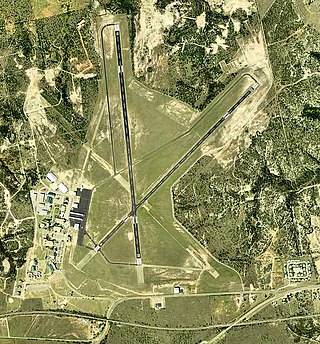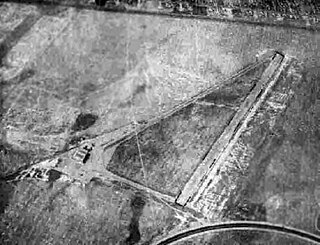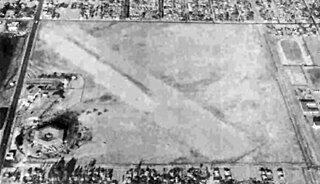
Hollywood Burbank Airport — formerly called Bob Hope Airport after entertainer Bob Hope — is a public airport three miles (4.8 km) northwest of downtown Burbank, in Los Angeles County, California, United States. The airport serves Burbank, Hollywood, and the northern Greater Los Angeles area, which includes Glendale, Pasadena, the San Fernando Valley and the Santa Clarita Valley. It is closer to many popular attractions, including Griffith Park, Universal Studios Hollywood, and Downtown Los Angeles, than Los Angeles International Airport (LAX), and it is the only airport in the area with a direct rail connection to Downtown Los Angeles, with service from two stations: Burbank Airport–North and Burbank Airport–South. Nonstop flights mostly serve cities in the western United States, though JetBlue has daily flights to New York City. Delta Air Lines also flies regular routes to Atlanta.
This is a list of aviation-related events from 1929:

Regina International Airport is an international airport located in Regina, Saskatchewan, Canada, located 2 nautical miles south-west and 7 kilometres (4.3 mi) west-southwest of the city centre. It is run by the Regina Airport Authority. In 2022, it was the 16th busiest airport in Canada.

Sydney John Chaplin was an English actor. Chaplin was the elder half-brother of actor and filmmaker Charlie Chaplin and in later life, served as his business manager.

Florence Regional Airport is three miles east of Florence, in Florence County, South Carolina, United States.
Grand Canyon Airlines is a 14 CFR Part 135 air carrier headquartered on the grounds of Boulder City Municipal Airport in Boulder City, Nevada, United States. It also has bases at Grand Canyon National Park Airport and Page Municipal Airport, both in Arizona. It operates sightseeing tours and charter service over and around the Grand Canyon. Its headquarters and main operation center is Grand Canyon National Park Airport and Boulder City Municipal Airport. The company slogan is With Grand Canyon Airlines, Your Memories are Cleared for Takeoff!

Hawthorne Nevada Airlines Flight 708 was a domestic non-scheduled passenger flight between Hawthorne Industrial Airport, Nevada (HTH) and Hollywood-Burbank Airport, California (BUR/KBUR) that crashed into terrain near the tallest mountain in the contiguous United States, Mount Whitney, near Lone Pine, on February 18, 1969, killing all 35 passengers and crew on board.

Bader Field, also known as Atlantic City Municipal Airport, was a city-owned public-use general aviation airport located in Atlantic City, in Atlantic County, New Jersey, United States. It was named after the former mayor of Atlantic City, Edward L. Bader. The airport-turned field is located in Chelsea Heights, Atlantic City.
Moye Wicks Stephens was an American aviator and businessman. He was a pioneer in aviation, circumnavigating the globe with adventure writer Richard Halliburton in 1931, and co-founding Northrop Aircraft, Inc.

Avenger Field is a Texas airport in Nolan County, three miles west of Sweetwater. The National Plan of Integrated Airport Systems for 2011–2015 called it a general aviation facility.

Grand Central Airport is a former airport in Glendale, California. Also known as Grand Central Air Terminal (GCAT), the airport was an important facility for the growing Los Angeles suburb of Glendale in the 1920s and a key element in the development of United States aviation. The terminal, located at 1310 Air Way, was built in 1928 and still exists, owned since 1997 by The Walt Disney Company as a part of its Grand Central Creative Campus (GC3). Three hangars also remain standing. The location of the single concrete 3,800-foot (1,200 m) runway has been preserved, but is now a public street as the runway was dug up and converted into Grand Central Avenue.
The Curtiss-Wright Technical Institute was an early professional trade school operated by the Curtiss-Wright corporation for aircraft maintenance training. Director Major C. C. Moseley was one of only three school directors selected across America to set the standards for the pre-World War II civilian pilot training program.

Robertson Aircraft Corporation was a post-World War I American aviation service company based at the Lambert-St. Louis Flying Field near St. Louis, Missouri, that flew passengers and U.S. Air Mail, gave flying lessons, and performed exhibition flights. It also modified, re-manufactured, and resold surplus military aircraft including Standard J, Curtiss Jenny/Canuck, DeHavilland DH-4, Curtiss Oriole, Spad, Waco, and Travel Air types in addition to Curtiss OX-5 engines.

Standard Air Lines Flight 897R was a domestic passenger flight between Albuquerque, New Mexico and Burbank, California. At 7:43am on July 12, 1949, the flight, operated by a Curtiss C-46E, crashed in Chatsworth, California, upon approach to Burbank, killing 35 of the 48 passengers and crew on board.

The Great Air Robbery is a six-reel silent 1919 American drama film directed by Jacques Jaccard and produced by Universal Pictures. The film stars Ormer Locklear, Allan Forrest and Ray Ripley. The Great Air Robbery is a film that showcases the talents of stunt pilot Locklear, considered the foremost "aviation stunt man in the world", and depicts pilots flying air mail, the first film to deal with the subject. There are no known archival holdings of the film, so it is presumably a lost film.

Dallas Love Field is a city-owned public airport in the neighborhood of Love Field, 6 miles northwest of downtown Dallas, Texas. It was Dallas' main airport until 1974 when Dallas Fort Worth International Airport (DFW) opened. Love Field covers an area of 1,300 acres (530 ha) at an elevation of 487 feet (148 m) above mean sea level and has two runways.

Vail Airport, Montebello was an airport in Montebello, California from 1926 to 1953. The airport was owned and operated by Western Air Express. Western Air Express purchased 700 acres of Vail farm to build the private airport from the Vail brothers. The vast airport was boarded by Telegraph Road on the south, Ferguson Drive on the north, Tusbway Avenue on the west, and Yates Avenue to the east. A group of Los Angeles entrepreneurs founded Western Air Express and the airport to cash in on the Air Mail Act of 1925 that opened up bidding on air mail contracts. Western Air Express purchased six Douglas mailplanes model M-2 to start the company. Western Air Express built two 2 unpaved runways running north–south in the middle of the lot, along the current Yates Avenue. A nearby movie studio building was turned into the main hangar and three more were built. Western Air Express won an airmail contract run from Las Vegas to Salt Lake City in 1926. In 1927 the local airport became famous as Charles Lindbergh landed The Spirit of St. Louis at the airport on a nationwide. Leland A. Bryant designed and built his racing aircraft at Vail Airport starting in 1927. Ryan Mechanics built the Lone Eagle CM-1 at Vail Airport in 1928.

Alhambra Airport also called the Western Air College Airport was an airport in Alhambra, California from 1928 to 1946. The Airport was founded by the Western Air Express on 157-acre of land. The airport had a single 2,830-foot asphalt northeast–southwest runway. The Western Air Express built a unique hangar, that was a 44-foot hexagonal shape able to work on 6 aircraft at once. Western Air Express also build an air terminal building and a conventional hangar. Western Air Express at the opening operated Fokker F-32 from the airport. Western Air Express held a large dedication ceremony on April 17, 1930 for the new air terminal. The US Forest Service operated a patrol aircraft out of the airport to keep an eye out on the nearby San Gabriel Mountains. Just one year after the dedication ceremony, both Western Air Express and Transcontinental, which also had flights out of the airport, moved to the Burbank Airport and Glendale Grand Central Airport. With no scheduled flights, the Alhambra Airport became a private airport. A Western Air College flight school opened at the airport and some other small commercial operations. With Hollywood only 15 miles away the Alhambra Airport became a popular spot to shoot movies. The 1936 movie 13 Hours by Air directed by Mitchell Leisen and starring Fred MacMurray and Joan Bennett was shot at the airport. In 1939 the film Danger Flight was shot at the airport, directed by Howard Bretherton, starring John Trent as Tailspin Tommy Tompkins, Marjorie Reynolds, Milburn Stone and Jason Robards Sr. The film featured young aviation enthusiasts in a model club. The four-seat cabin monoplane, Harlow PJC-2 designed by Max B. Harlow was built at the Alhambra Airport in 1937. To support the build-up of the World War 2 effort, the Alhambra Airport was used as a depot for Lockheed Corporation military airplanes, many P-38 Lightning fighters aircraft came, were packed and departed the depot on the Lend Lease Program. In 1941 the Flying Wild and They Met in Bombay were shot at the airport. In 1942 the movie Flight Lieutenant was shot at the airport. In 1943 the airport was sold to the city. Harlow Aircraft Company purchased the airport in 1945. Harlow Aircraft Company had been building small aircraft at the airport since 1936 in small qualities. In 1946 Harlow Aircraft Company sold the airport to real estate developers, the north part of the site is now commercial property and the remaining is houses. The Airport was located at what is now Valley Boulevard to the north, New Ave to the east, Almansor Street to the west and the Interstate 10 to the south. Western Air Express later became part of Western Airlines. Western Air College Airport also operated out of the Rosemead Airport for some years. Western Air Express operated out of the Vail Airport in Montebello before moving its operation to the Alhambra Airport.

Columbia Field, originally Curtiss Field, is a former airfield near Valley Stream within the Town of Hempstead on Long Island, New York. Between 1929 and 1933 it was a public airfield named Curtiss Field after the Curtiss-Wright aircraft corporation that owned it. The public airfield closed after 1933, but aircraft continued to be manufactured there primarily by Columbia Aircraft Corporation, which gave the private airfield its name.


















